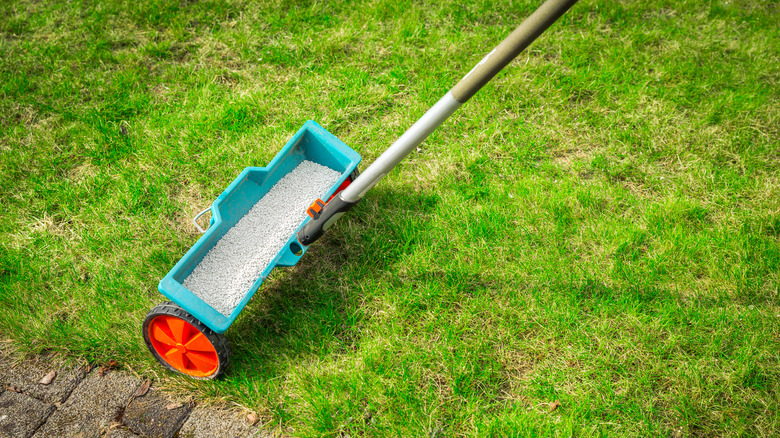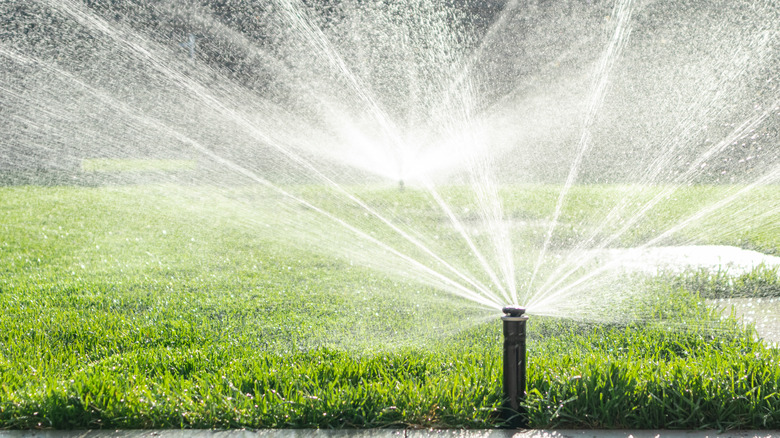The Best Time To Water Your Lawn After Applying Weed And Feed
If you love having a vibrant, sprawling lawn, then the process of weed and feed is probably no stranger to your lawn care routine. Weed and feed is a combination lawn care product designed to address two common issues: weed control and fertilization. The herbicides target a variety of weeds, such as dandelions and clover, while sparing the grass. Simultaneously, the fertilizer provides essential nutrients like nitrogen, phosphorus, and potassium to promote healthy grass growth. Weed and feed products are typically applied in granular form using a spreader, the timing will vary depending on the specific product and regional climate. Regular use of weed and feed can help maintain your lush, weed-free lawn by addressing weed growth and promoting grass health. However, you should wait before hydrating your lawn after applying weed and feed. Refrain from watering for a minimum of 12 hours.
It's best to wait 12 to 24 hours after applying weed and feed to water your lawn to allow the product to fully settle and activate. Waiting for 24 hours is optimal as it provides sufficient time for the weed-killing ingredients to adhere to the weeds and for the fertilizer to penetrate the soil effectively. This waiting period ensures the product isn't washed away by immediate watering, maximizing its effectiveness in controlling weeds and promoting healthy grass growth. Additionally, allowing 24 hours before watering minimizes the risk of nutrient runoff so your lawn receives the full benefits of the applied weed and feed treatment.
How to water your lawn after weed and feed
After applying weed and feed to your lawn, proper watering is essential to maximize its effectiveness. Ensure that the product has been evenly distributed across the lawn. After waiting 12 to 24 hours, water your lawn thoroughly to activate the weed-killing ingredients and allow the fertilizer to penetrate the soil. Aim for deep watering rather than frequent shallow watering. Deep watering encourages the roots to grow deeper into the soil, making the grass more resilient to drought and stress. To achieve deep watering, water the lawn for a longer duration but less frequently, ensuring that the soil is moistened to a depth of at least 6 inches.
Consider using a sprinkler system or a hose with a sprinkler attachment to water the lawn evenly. This helps prevent a soggy lawn due to overwatering or drying out from underwatering, ensuring consistent coverage. Monitor the weather conditions and adjust your watering schedule accordingly. During periods of hot weather or drought, your lawn may require more frequent watering to prevent stress. Conversely, during cooler or rainy periods, reduce the watering frequency to avoid overwatering and potential runoff and nutrient leaching.
Finally, avoid watering during the hottest part of the day to minimize water loss through evaporation. Instead, aim to water your lawn in the early morning or late afternoon when temperatures are cooler, allowing the water to soak into the soil effectively.
Precautions for weed and feed
While weed and feed products can be effective in controlling weeds and nourishing your lawn, there are cautions to consider to use them safely and efficiently. One major concern is the potential for overapplication, which can damage your lawn or surrounding vegetation. Carefully follow the manufacturer's instructions regarding the proper application rates and techniques to avoid applying too much product.
Another caution to be aware of is the potential harm to non-target plants. Weed and feed products contain herbicides designed to kill broadleaf weeds, but they can also harm desirable plants if not applied carefully. Take care to avoid overspray onto flower beds, shrubs, or other ornamental plants, and consider using a targeted application method for precise weed control.
Always read and follow the safety precautions outlined on the product label, including wearing appropriate protective gear during application and keeping children and pets away from treated areas until the product has dried. By following these tips you can safely and appropriately apply your lawn care products for a vibrant, healthy lawn.


